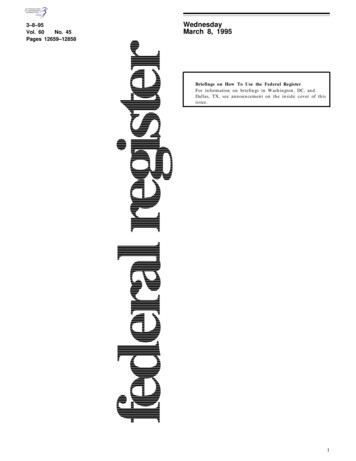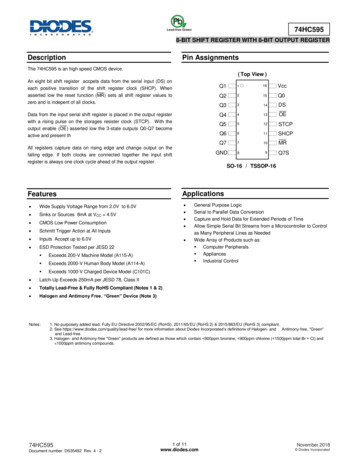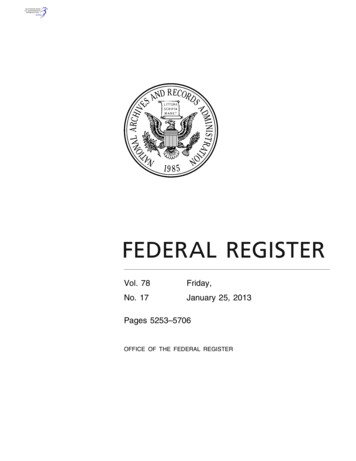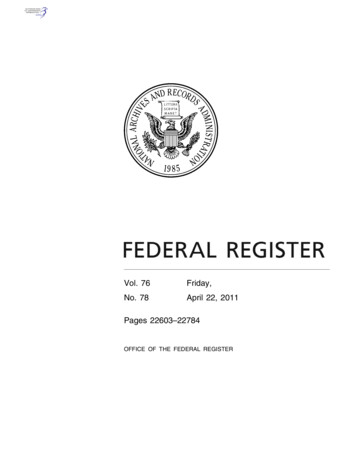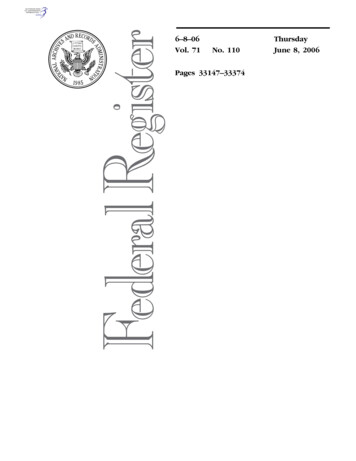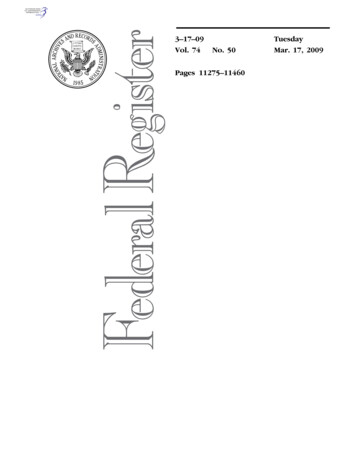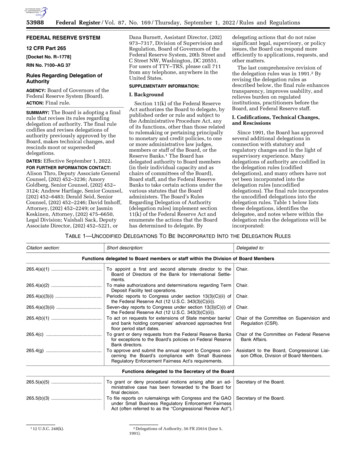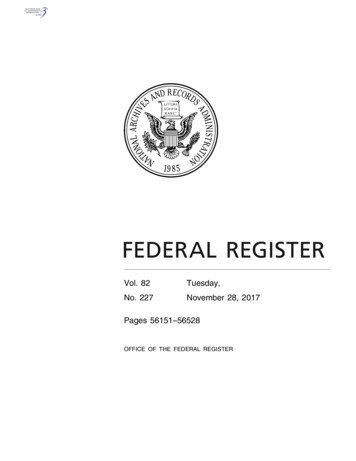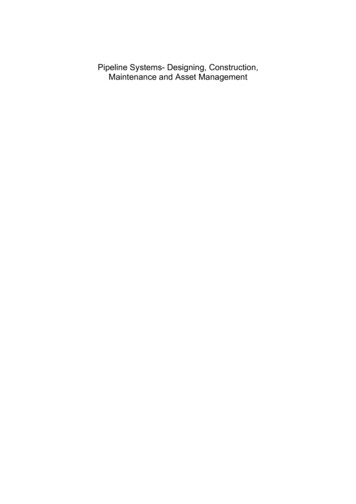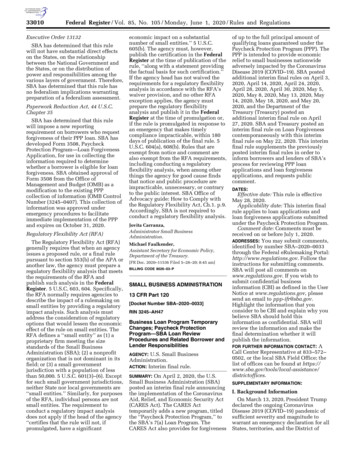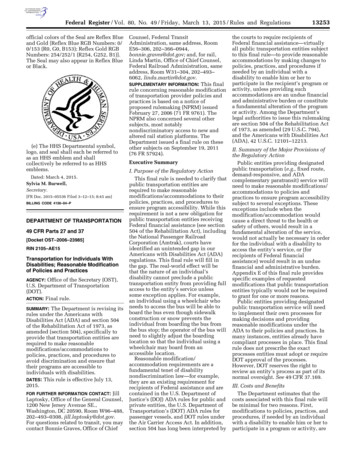
Transcription
Federal Register / Vol. 80, No. 49 / Friday, March 13, 2015 / Rules and Regulations(e) The HHS Departmental symbol,logo, and seal shall each be referred toas an HHS emblem and shallcollectively be referred to as HHSemblems.Dated: March 4, 2015.Sylvia M. Burwell,Secretary.[FR Doc. 2015–05536 Filed 3–12–15; 8:45 am]BILLING CODE 4150–04–PDEPARTMENT OF TRANSPORTATION49 CFR Parts 27 and 37[Docket OST–2006–23985]RIN 2105–AE15Transportation for Individuals WithDisabilities; Reasonable Modificationof Policies and PracticesOffice of the Secretary (OST),U.S. Department of Transportation(DOT).ACTION: Final rule.AGENCY:The Department is revising itsrules under the Americans withDisabilities Act (ADA) and section 504of the Rehabilitation Act of 1973, asamended (section 504), specifically toprovide that transportation entities arerequired to make reasonablemodifications/accommodations topolicies, practices, and procedures toavoid discrimination and ensure thattheir programs are accessible toindividuals with disabilities.DATES: This rule is effective July 13,2015.tkelley on DSK3SPTVN1PROD with RULESSUMMARY:JillLaptosky, Office of the General Counsel,1200 New Jersey Avenue SE.,Washington, DC 20590, Room W96–488,202–493–0308, jill.laptosky@dot.gov.For questions related to transit, you maycontact Bonnie Graves, Office of ChiefFOR FURTHER INFORMATION CONTACT:VerDate Sep 11 201416:34 Mar 12, 2015Jkt 235001Counsel, Federal TransitAdministration, same address, RoomE56–306, 202–366–0944,bonnie.graves@dot.gov; and, for rail,Linda Martin, Office of Chief Counsel,Federal Railroad Administration, sameaddress, Room W31–304, 202–493–6062, linda.martin@dot.gov.SUPPLEMENTARY INFORMATION: This finalrule concerning reasonable modificationof transportation provider policies andpractices is based on a notice ofproposed rulemaking (NPRM) issuedFebruary 27, 2006 (71 FR 9761). TheNPRM also concerned several othersubjects, most notablynondiscriminatory access to new andaltered rail station platforms. TheDepartment issued a final rule on theseother subjects on September 19, 2011(76 FR 57924).Executive SummaryI. Purpose of the Regulatory ActionThis final rule is needed to clarify thatpublic transportation entities arerequired to make reasonablemodifications/accommodations to theirpolicies, practices, and procedures toensure program accessibility. While thisrequirement is not a new obligation forpublic transportation entities receivingFederal financial assistance (see section504 of the Rehabilitation Act), includingthe National Passenger RailroadCorporation (Amtrak), courts haveidentified an unintended gap in ourAmericans with Disabilities Act (ADA)regulations. This final rule will fill inthe gap. The real-world effect will bethat the nature of an individual’sdisability cannot preclude a publictransportation entity from providing fullaccess to the entity’s service unlesssome exception applies. For example,an individual using a wheelchair whoneeds to access the bus will be able toboard the bus even though sidewalkconstruction or snow prevents theindividual from boarding the bus fromthe bus stop; the operator of the bus willneed to slightly adjust the boardinglocation so that the individual using awheelchair may board from anaccessible location.Reasonable modification/accommodation requirements are afundamental tenet of disabilitynondiscrimination law—for example,they are an existing requirement forrecipients of Federal assistance and arecontained in the U.S. Department ofJustice’s (DOJ) ADA rules for public andprivate entities, the U.S. Department ofTransportation’s (DOT) ADA rules forpassenger vessels, and DOT rules underthe Air Carrier Access Act. In addition,section 504 has long been interpreted byPO 00000Frm 00055Fmt 4700Sfmt 4700the courts to require recipients ofFederal financial assistance—virtuallyall public transportation entities subjectto this final rule—to provide reasonableaccommodations by making changes topolicies, practices, and procedures ifneeded by an individual with adisability to enable him or her toparticipate in the recipient’s program oractivity, unless providing suchaccommodations are an undue financialand administrative burden or constitutea fundamental alteration of the programor activity. Among the Department’slegal authorities to issue this rulemakingare section 504 of the Rehabilitation Actof 1973, as amended (29 U.S.C. 794),and the Americans with Disabilities Act(ADA), 42 U.S.C. 12101–12213.II. Summary of the Major Provisions ofthe Regulatory ActionPublic entities providing designatedpublic transportation (e.g., fixed route,demand-responsive, and ADAcomplementary paratransit) service willneed to make reasonable modifications/accommodations to policies andpractices to ensure program accessibilitysubject to several exceptions. Theseexceptions include when themodification/accommodation wouldcause a direct threat to the health orsafety of others, would result in afundamental alteration of the service,would not actually be necessary in orderfor the individual with a disability toaccess the entity’s service, or (forrecipients of Federal financialassistance) would result in an unduefinancial and administrative burden.Appendix E of this final rule providesspecific examples of requestedmodifications that public transportationentities typically would not be requiredto grant for one or more reasons.Public entities providing designatedpublic transportation service will needto implement their own processes formaking decisions and providingreasonable modifications under theADA to their policies and practices. Inmany instances, entities already havecompliant processes in place. This finalrule does not prescribe the exactprocesses entities must adopt or requireDOT approval of the processes.However, DOT reserves the right toreview an entity’s process as part of itsnormal oversight. See 49 CFR 37.169.III. Costs and BenefitsThe Department estimates that thecosts associated with this final rule willbe minimal for two reasons. First,modifications to policies, practices, andprocedures, if needed by an individualwith a disability to enable him or her toparticipate in a program or activity, areE:\FR\FM\13MRR1.SGM13MRR1ER13MR15.004 /GPH official colors of the Seal are Reflex Blueand Gold [Reflex Blue RGB Numbers: 0/0/153 (R0, G0, B153); Reflex Gold RGBNumbers: 254/252/1 (R254, G252, B1)].The Seal may also appear in Reflex Blueor Black.13253
13254Federal Register / Vol. 80, No. 49 / Friday, March 13, 2015 / Rules and Regulationsalready required by other Federal lawthat applies to recipients of Federalfinancial assistance. Since virtuallyevery entity subject to this final rulereceives Federal financial assistance,each entity should already be modifyingits policies, practices, and procedureswhen necessary. Second, the reasonablemodification/accommodationrequirements contained in this final ruleare not very different from the origin-todestination requirement alreadyapplicable to complementary paratransitservice, as required by current DOTregulations at 49 CFR 37.129(a) and asdescribed in its implementing guidance.tkelley on DSK3SPTVN1PROD with RULESThe Reasonable Modification NPRMThrough amendments to theDepartment’s ADA regulations at 49CFR 37.5 and 37.169, the NPRMproposed that transportation entities,including, but not limited to, publictransportation entities required toprovide complementary paratransitservice, must make reasonablemodifications to their policies andpractices to avoid discrimination on thebasis of disability and ensure programaccessibility. Making reasonablemodifications to policies and practicesis a fundamental tenet of disabilitynondiscrimination law, reflected in anumber of DOT (e.g., 49 CFR 27.11(c)(3),14 CFR 382.7(c)) and DOJ (e.g., 28 CFR35.130(b)(7)) regulations. Moreover,since at least 1979, section 504 has beeninterpreted to require recipients ofFederal financial assistance to providereasonable accommodations to programbeneficiaries. See, e.g., Alexander v.Choate, 469 U.S. 287 (1985);Southeastern Community College v.Davis, 442 U.S. 397 (1979). Inaccordance with these decisions of theU.S. Supreme Court (e.g., Choate andDavis), the obligation to modify policies,practices, and procedures is alongstanding obligation under section504, and the U.S. Department of Justice,which has coordination authority forsection 504 pursuant to Executive Order12250, is in agreement with thisinterpretation.However, as the NPRM explained,DOT’s ADA regulations do not includelanguage specifically requiring regulatedparties to make reasonablemodifications to policies and practices.The Department, when drafting 49 CFRpart 37, intended that § 37.21(c) wouldincorporate the DOJ provisions on thissubject, by saying the following:Entities to which this part applies also maybe subject to ADA regulations of theDepartment of Justice (28 CFR parts 35 or 36,as applicable). The provisions of this partshall be interpreted in a manner that willVerDate Sep 11 201416:34 Mar 12, 2015Jkt 235001make them consistent with applicableDepartment of Justice regulations.Under this language, provisions of theDOJ regulations concerning reasonablemodifications of policies and practicesapplicable to public entities, such as 28CFR 35.130(b)(7), could apply to publicentities regulated by DOT, whileprovisions of DOJ regulations on thissubject applicable to private entities(e.g., 28 CFR 36.302) could apply toprivate entities regulated by DOT. A1997 court decision appeared to sharethe Department’s intention regarding therelationship between DOT and DOJrequirements (Burkhart v. WashingtonArea Metropolitan Transit Authority,112 F.3d 1207 (D.C. Cir. 1997)).However, more recent cases thataddressed the issue directly held that, inthe absence of a DOT regulationexplicitly requiring transportationentities to make reasonablemodifications, transportation entitieswere not obligated to make suchmodifications under the ADA. Theleading case on this issue was Melton v.Dallas Area Rapid Transit (DART), 391F.3d 669 (5th Cir. 2004); cert. denied125 S. Ct. 2273 (2005). In this case, thecourt upheld DART’s refusal to pick upa paratransit passenger with a disabilityin a public alley behind his house,rather than in front of his house (wherea steep slope allegedly precluded accessby the passenger to DART vehicles). TheDART argued that paratransit operationsare not covered by DOJ regulations.‘‘Instead,’’ as the court summarizedDART’s argument, ‘‘paratransit servicesare subject only to Department ofTransportation regulations found in 49CFR part 37. The Department ofTransportation regulations contain noanalogous provision requiringreasonable modification to be made toparatransit services to avoiddiscrimination.’’ 391 F.3d at 673.The court essentially adopted DART’sargument, noting that the permissivelanguage of § 37.21(c) (‘‘may besubject’’) did not impose coverage underprovisions of DOJ regulations which, bytheir own terms, provided that publictransportation programs were ‘‘notsubject to the requirements of [28 CFRpart 35].’’ See 391 F.3d at 675. ‘‘It isundisputed,’’ the court concludedthat the Secretary of Transportation has beendirected by statute to issue regulationsrelating specifically to paratransittransportation. Furthermore, even if theSecretary only has the authority topromulgate regulations relating directly totransportation, the reasonable modificationrequested by the Meltons relates specificallyto the operation of DART’s service and is,therefore, exempt from the [DOJ] regulationsin 28 CFR Part 35.PO 00000Frm 00056Fmt 4700Sfmt 4700Id. Two other cases, Boose v. Tri-CountyMetropolitan Transportation District ofOregon, 587 F.3d 997 (9th Cir. 2009)and Abrahams v. MTA Long Island Bus,644 F.3d 110 (2d Cir. 2011),subsequently agreed with Melton.Because the Department believed that,as in all other areas of disabilitynondiscrimination law, makingreasonable modifications to policies andpractices is a crucial element ofnondiscriminatory and accessibleservice to people with disabilities, weproposed to fill the gap the courts hadidentified in our regulations.Consequently, the 2006 NPRM proposedamending the DOT rules to require thattransportation entities, both fixed routeand paratransit, make reasonablemodifications in the provisions of theirservices when doing so is necessary toavoid discrimination or to provideprogram accessibility to services.In § 37.5, the generalnondiscrimination section of the ADArule, the Department proposed to add aparagraph requiring all public entitiesproviding designated publictransportation to make reasonablemodifications to policies and practiceswhere needed to avoid discriminationon the basis of disability or to provideprogram accessibility to services. Thelanguage was based on DOJ’srequirements and, like the DOJregulation, would not require amodification if doing so wouldfundamentally alter the nature of theentity’s service.The NPRM also proposed to placeparallel language in a revised § 37.169,replacing an obsolete provision relatedto over-the-road buses. Under theproposal, in order to deny a request fora modification, the head of a publicentity providing designated publictransportation services would have hadto make a written determination that aneeded reasonable modification createda fundamental alteration or undueburden. The entity would not have beenrequired to seek DOT approval for thedetermination, but DOT could reviewthe entity’s action (e.g., in the context ofa complaint investigation or compliancereview) as part of a determination aboutwhether the entity had discriminatedagainst persons with disabilities. In thecase where the entity determined that arequested modification created afundamental alteration or undueburden, the entity would be obligated toseek an alternative solution that wouldnot create such an undue burden orfundamental alteration.The ADA and part 37 containnumerous provisions requiringtransportation entities to ensure thatpersons with disabilities can access andE:\FR\FM\13MRR1.SGM13MRR1
tkelley on DSK3SPTVN1PROD with RULESFederal Register / Vol. 80, No. 49 / Friday, March 13, 2015 / Rules and Regulationsuse transportation services on anondiscriminatory basis. Some of theseprovisions relate to the acquisition ofvehicles or the construction or alterationof transportation facilities. Othersconcern the provision of service bypublic and private entities, in modesranging from public demand-responsiveservice for the general public to privateover-the-road buses. Still others concernthe provision of complementaryparatransit service.In all of these cases, publictransportation entities are likely to putpolicies and procedures in place tocarry out applicable requirements. Inorder to achieve the objectives of theunderlying requirements in certainindividual cases, entities may need todepart from these otherwise acceptablepolicies. This final rule concerns thescope of situations in which suchdepartures—i.e., reasonablemodifications—are essential. Theunderlying provisions of the ruledescribe the ‘‘bottom line’’ of whattransportation entities must achieve.This reasonable modification ruledescribes how transportation entities getto that ‘‘bottom line’’ in individualsituations where entities’ normalprocedures do not achieve the intendedresult.As comments to the NPRM madeclear, an important concern oftransportation entities is that the DOTfinal rule makes it possible tounderstand clearly what modificationsare expected; in other words, whichrequested modifications would be‘‘reasonable’’ and which would not. Forexample, in the fixed route context, webelieve that stopping a bus a shortdistance from a bus stop sign to allowa wheelchair user to avoid an obstacleto boarding using a lift (e.g., a utilityrepair, a snowdrift) would generally bereasonable. Establishing a ‘‘flag stop’’policy that allowed a passenger to boarda bus anywhere, without regard to busstop locations, would not. In thecomplementary paratransit context, theDepartment would expect, in manycircumstances, that drivers wouldprovide assistance outside a vehiclewhere needed to overcome an obstacle,but drivers would not have to providepersonal services that extend beyondthe doorway into a building to assist apassenger. Appendix E to this final ruleaddresses issues of this kind in greaterdetail.In addition to the ‘‘modification ofpolicies’’ language from the DOJ ADArules, there are other features of thoserules that are not presently incorporatedin the DOT ADA rules (e.g., pertainingto auxiliary aids and services). TheNPRM sought comment on whether itVerDate Sep 11 201416:34 Mar 12, 2015Jkt 235001would be useful to incorporate anyadditional provisions from the DOJ rulesinto Part 37.Comments to the NPRMThe Department received over 300comments on the reasonablemodification provisions of the NPRM.These comments were received duringthe original comment period, a publicmeeting held in August 2010, and areopened comment period at the time ofthat meeting. The comments werepolarized, with almost all disabilitycommunity commenters favoring theproposal and almost all transit industrycommenters opposing it.The major themes in transit industrycomments opposing the proposal werethe following. Many transit industrycommenters opposed the application ofthe concept of reasonable modificationto transportation, and a few commentersargued that it was not the job of transitentities to surmount barriers existing incommunities. Many transit commenterssaid that the rule would force them tomake too many individual, case-by-casedecisions, making programadministration burdensome, leading topressure to take unreasonable actions,creating the potential for litigation, andmaking service slower and less reliable.Some of these commenters also objectedto the proposal that the head of anentity, or his designee, would berequired to make the decision that arequested modification was afundamental alteration or would resultin an undue burden, and provide awritten decision to the requestor, statingthis requirement would take substantialstaff time to complete. Manycommenters provided examples or, insome cases, extensive lists, of the kindsof modifications they had been asked ormight be asked to make, many of whichthey believed were unreasonable. Anumber of commenters said the rulewould force paratransit operators tooperate in a door-to-door mode,eliminating, as a practical matter, thecurb-to-curb service option. A majorcomment from many transit industrysources was that reasonablemodification would unreasonably raisethe costs of providing paratransit. Pertrip costs would rise, variouscommenters said, because of increaseddwell time at stops, the need foradditional personnel (e.g., an extra staffperson on vehicles to assist passengers),increased insurance costs, lower serviceproductivity, increased need fortraining, or preventing providers fromcharging fees for what they wouldotherwise view as premium service.Some of these commenters attachednumbers to their predictions ofPO 00000Frm 00057Fmt 4700Sfmt 470013255increased costs (e.g., the costs ofparatransit would rise from 22–50percent, nationwide costs would rise by 1.89–2.7 billion), though, with fewexceptions, these numbers appeared tobe based on extrapolations premised onassumptions about the requirements ofthe NPRM that were contrary to thelanguage of the NPRM’s regulatory textand preamble or on no analysis at all.Commenters opposed to the proposalalso raised safety issues, againprincipally in the context of paratransit.Making some reasonable modificationswould force drivers to leave vehicles,commenters said. This could result inother passengers being left alone, whichcould expose them to hazards. Driversleaving a vehicle would have to turn offthe vehicle’s engine, resulting in no airconditioning or heating for otherpassengers in the time the driver wasoutside the vehicle. The driver could beexposed to injury outside the vehicle(e.g., from a trip and fall).A smaller number of commenters alsoexpressed concern about the applicationof the reasonable modification conceptto fixed route bus service. Somecommenters said that the idea of busesstopping at other than a designated busstop was generally unsafe andburdensome, could cause delays, andimpair the clarity of service. A numberof these commenters appeared to believethat the NPRM could require transitentities to stop anywhere along a routewhere a person with a disability wasflagging a bus down, which they saidwould be a particularly burdensomepractice.Commenters also made legalarguments against the proposal. Somecommenters supported the approachtaken by the court in Melton. Otherssaid that the Department lacks statutoryauthority under the ADA to requirereasonable modification or thatreasonably modifying paratransitpolicies and practices would forceentities to exceed the ‘‘comparable’’service requirements of the statute.Some of these commenters said that theproposal would push entities too far inthe direction of providingindividualized, human service-typetransportation, rather than mass transit.A number of commenters also said thatit was good policy to maintain localoption for entities in terms of the servicethey provide. Others argued that theproposed action was inconsistent withstatutes or Executive Orders related tounfunded mandates and Federalism.A variety of commenters—in both thedisability community and transportationindustry—noted that a significantnumber of paratransit operators alreadyeither provide door-to-door service asE:\FR\FM\13MRR1.SGM13MRR1
13256Federal Register / Vol. 80, No. 49 / Friday, March 13, 2015 / Rules and Regulationstheir basic mode of service (somecommenters said as many as 50 percentof paratransit operators provide door-todoor service) or follow what, in effect,is curb-to-curb with reasonablemodification approach for paratransit,or allowed fixed route buses flexibilityin terms of where they stop. Some ofthese commenters said that transitoperators imposed conditions on thekind of modifications that could bemade (e.g., drivers could only leave thevehicle for a limited time or distance).In some cases, commenters said,while they use their discretion to makethe kinds of modifications the NPRMproposed, they wanted these actions toremain discretionary, rather than beingthe subject of a Federal mandate. Asmaller number of commenters askedfor additional guidance on expectationsunder a reasonable modification rule orfor clarification of an enforcementmechanism for the proposedrequirement.Disability community commenterswere virtually unanimous in supportingthe proposal, saying that curb-to-curbparatransit service was often inadequatefor some people with disabilities, who,in some circumstances, could not makeuse of ADA-mandated paratransitservice. For example, medical oxygenusers should not have to use part oftheir supply waiting at the curb for avehicle; blind passengers may needwayfinding assistance to get to or froma vehicle; or bad weather may makepassage to or from a vehicle undulydifficult for wheelchair users. Somedisability community commenterssupported the inclusion in the rule ofvarious other provisions of the DOJADA regulations (e.g., with respect toauxiliary aids and services).tkelley on DSK3SPTVN1PROD with RULESDOT Response to CommentsReasonable modification is a centralconcept of disability nondiscriminationlaw, based on the principle that it isessential for entities to considerindividuals with disabilities asindividuals, not simply as members ofa category. The concept recognizes thatentities may have general policies,legitimate on their face, that preventnondiscriminatory access to entities’service, programs, or facilities by someindividuals with disabilities under somecircumstances. The concept calls onentities to make individual exceptionsto these general policies, where neededto provide meaningful,nondiscriminatory access to services,programs, or facilities, unless makingsuch an exception would require afundamental alteration of an entity’sprograms.VerDate Sep 11 201416:34 Mar 12, 2015Jkt 235001Reasonable modification requirementsare part of existing requirements forrecipients of Federal financialassistance, DOJ ADA rules for publicand private entities, DOT ADA rules forpassenger vessels, and DOT rules underthe Air Carrier Access Act. In none ofthese contexts has the existence of areasonable modification requirementcreated a significant obstacle to theconduct of the wide variety of publicand private functions covered by theserules. Nor has it led to noticeableincreases in costs. At this point, surfacetransportation entities are the only classof entities not explicitly covered by anADA regulatory reasonable modificationrequirement. Having reviewed thecomments to this rulemaking, theDepartment has concluded thatcommenters failed to make a persuasivecase that there is legal justification forpublic transportation entities to betreated differently than othertransportation entities. Further, per theanalysis above, section 504 requiresentities receiving Federal financialassistance to make reasonableaccommodations to policies andpractices when necessary to providenondiscriminatory access to services.This existing requirement applies tonearly all public transportation entities.As stated in the NPRM, DOTrecognizes that not all requests byindividuals with disabilities formodifications of transportation providerpolicies are, in fact, reasonable. TheNPRM recognized three types ofmodifications that would not create anobligation for a transportation providerto agree with a request: (1) Those thatwould fundamentally alter theprovider’s program, (2) those that wouldcreate a direct threat, as defined in 49CFR 37.3, as a significant risk to thehealth or safety of others, and (3) thosethat are not necessary to enable anindividual to receive the provider’sservices. The NPRM provided someexamples of modifications that shouldbe or need not be granted. Commentersfrom both the disability community andthe transit industry provided a vastlylarger set of examples of modificationsthat they had encountered or believedeither should or should not be granted.To respond to commenters’ concernsthat, given the wide variety of requeststhat can be made, it is too difficult tomake the judgment calls involved, theDepartment has created an Appendix Eto its ADA regulation that lists examplesof types of requests that we believe, inmost cases, either will be reasonable ornot. This guidance recognizes that,given the wide variety of circumstanceswith which transportation entities andpassengers deal, there may be somePO 00000Frm 00058Fmt 4700Sfmt 4700generally reasonable requests that couldjustly be denied in some circumstances,and some requests that generally neednot be granted that should be granted inother circumstances. In addition, werecognize that no list of potentialrequests can ever be completelycomprehensive, since the possiblesituations that can arise are far morevaried than can be set down in anydocument. That said, we hope that thisAppendix will successfully guidetransportation entities’ actions in asubstantial majority of the kinds ofsituations commenters have called toour attention, substantially reducing thenumber of situations in which fromscratch judgment calls would need to bemade, and will provide anunderstandable framework fortransportation entities’ thinking aboutspecific requests not listed. Of course, asthe Department learns of situations notcovered in the Appendix, we may addto it.The Department wants again to makeclear that, as stated in the preamble tothe last rulemaking:[the] September 2005 guidance concerningorigin-to-destination service remains theDepartment’s interpretation of the obligationsof ADA complementary paratransit providersunder existing regulations. As with otherinterpretations of regulatory provisions, theDepartment will rely on this interpretation inimplementing and enforcing the origin-todestination requirement of part 37. 76 FR57924, 57934 (Sept. 19, 2011).Thus, achieving the objective ofproviding origin-to-destination servicedoes not require entities to make doorto-door service their basic mode ofservice provision. It remains entirelyconsistent with the Department’s ADArule to provide ADA complementaryparatransit in a curb-to-curb mode.When a paratransit operator does so,however, it would need to makeexceptions to its normal curb-to-curbpolicy where a passenger with adisability makes a request for assistancebeyond curb-to-curb service that isneeded to provide access to the serviceand does not result in a fundamentalalteration or direct threat to the healthor safety of others. Given the largenumber of comments on this issue, andto further clarify the Department’sposition on this, we have added adefinition of ‘‘origin-to-destination’’ inpart 37.As commenters noted, a significantnumber of paratransit operators alreadyfollow an origin-to-destination policythat addresses the needs of passengersthat require assistance beyond the curbin order to use the paratransit service.This fact necessarily means that theseproviders can and do handle individualE:\FR\FM\13MRR1.SGM13MRR1
tkelley on DSK3SPTVN1PROD with RULESFederal Register / Vol. 80, No. 49 / Friday, March 13, 2015 / Rules and Regulationsrequests successfully. When asignificant number of complementaryparatransit systems already doessentially what this rule requires, ormore, it is difficult to argue that itcannot be done without encounteringinsuperable problems.To respond to commenters’ concernsabout an asserted onerous reviewprocess of requested modifications, theDepartment has removed therequirement that a response to a requestbe in writing, and is amending thecomplaint procedure in 49 CFR 27.13,and then mirroring that provision in anew section 37.17, to ensure it appliesnot just to recipients of Federal fundsbut to all designated publictransportation entities. A person who isdenied a modification may file acomplaint with the entity, but theprocess would be the same as w
13254 Federal Register/Vol. 80, No. 49/Friday, March 13, 2015/Rules and Regulations already required by other Federal law that applies to recipients of Federal financial assistance. Since virtually every entity subject to this final rule
